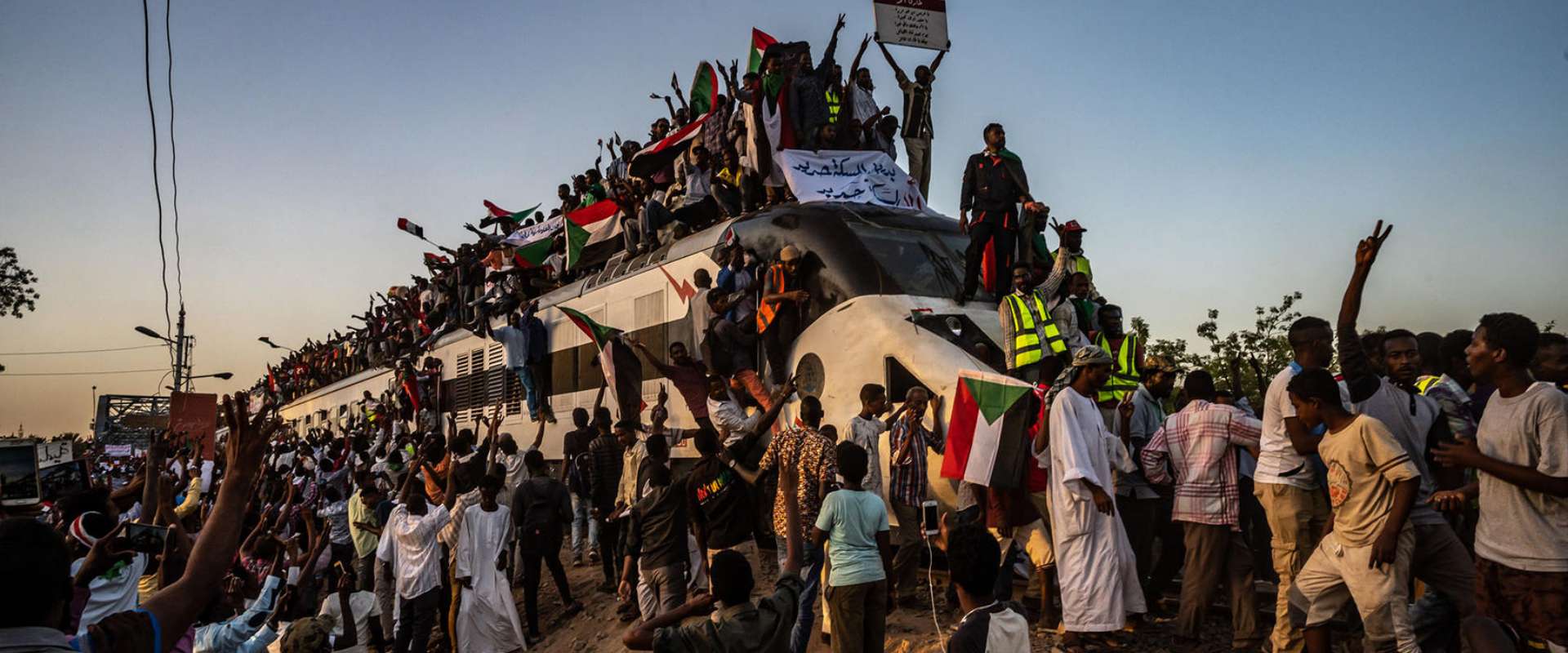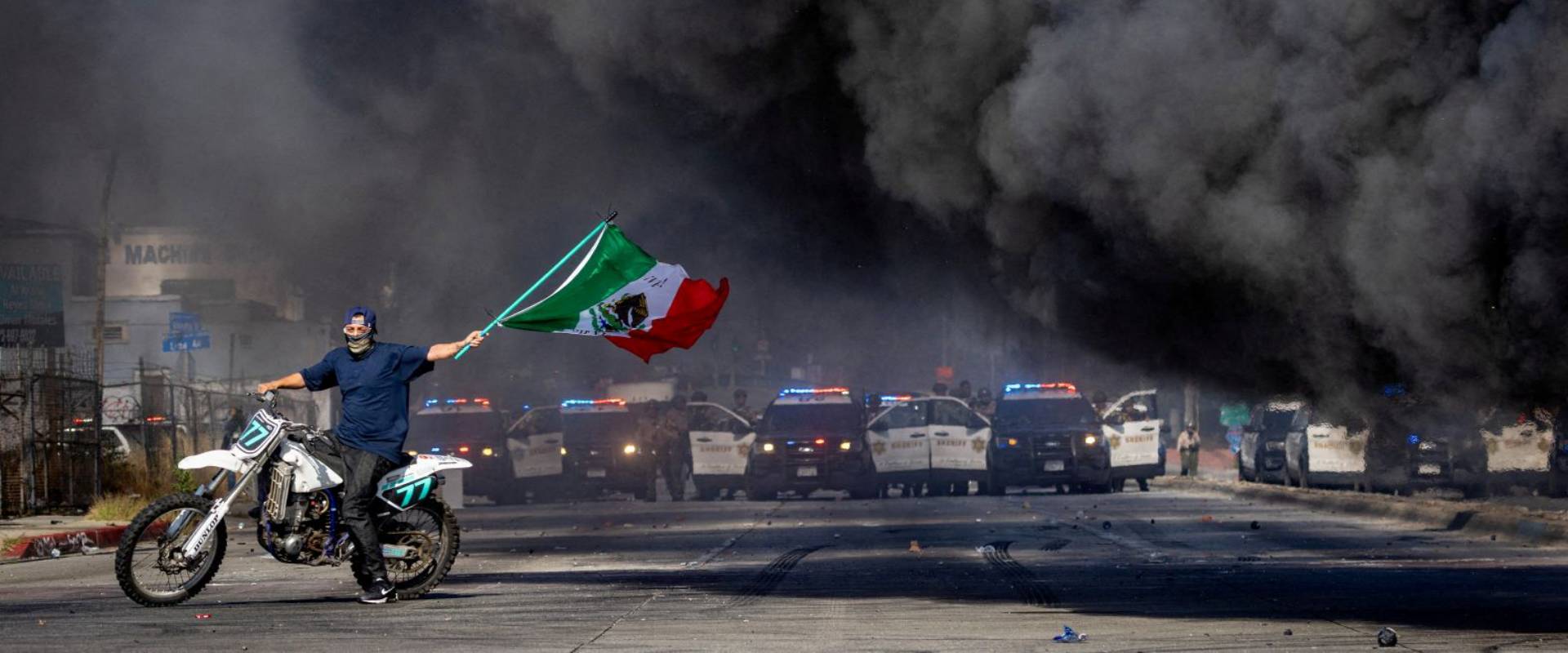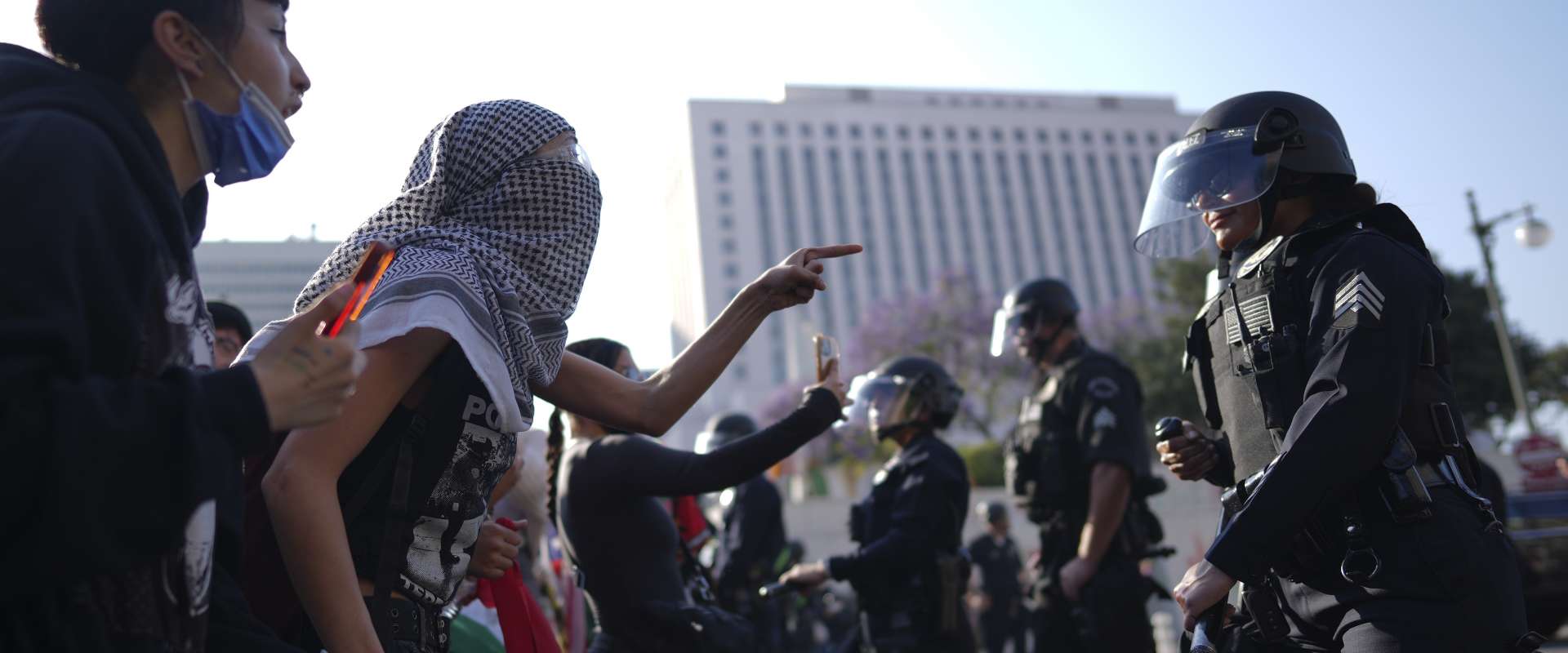The outbreak of civil war in Sudan in April 2023 plunged the country into one of the world’s most devastating humanitarian crises. The current war, pitting against each other two reactionary forces — the Sudanese Armed Forces (SAF) and the Rapid Support Forces (RSF) — erupted out of the ashes of the mass-led Glorious Revolution of 2019 which toppled Islamist dictator and neoliberal plunderer Omar Al Bashir.
In the service of a land and resource grab, the SAF and the RSF, backed by regional and imperialist powers, have visited the world’s deadliest famine in 40 years on the country’s 51 million people. The two armed forces have inflicted mass killings, gender-based violence and torture, extrajudicial killings, and other heinous violations on the people. Deploying crude Arab supremacism, the RSF is carrying out an ethnic-cleansing campaign against Darfur’s Masalit people.
Hopes for navigating the crisis, for survival, and for a future of human dignity for the Sudanese people rest on the shoulders of the youth-led and women-led resistance committees. Birthed during the revolution, these principled, democratic networks of citizens are still active in supporting the people’s basic needs and in consciousness-raising. Impressive as they are, these committees struggle with limitations that could undermine the struggle against their vicious and determined reactionary opponents.
Background to the revolution
On April 15, 2023 the alliance between the SAF under General Abdelfatih Burhan and the RSF under Mohamed Hamdan Dagalo (AKA “Hemedti”) collapsed, triggering the current war. Starting around the capital, Khartoum, it had spread across the entire country by the end of 2023.
Since then, the war has displaced over nine million people, about one million of whom have left the country. Food insecurity now afflicts 60 percent of the population, with the World Food Program reporting that Sudan is now experiencing the world’s worst hunger crisis. Both the SAF and the RSF are targeting medical facilities, 70 percent of which are now non-functioning. Deaths from curable and operable conditions and injuries are on the rise.
As Khaled Mustafa Medani argues in an excellent recent issue of Middle East Report devoted to Sudan, this is a counterrevolutionary war in the aftermath of the 2019 revolution. The war, Medani reports, risks the collapse of the Sudanese state along with instability in the wider Sahel and Horn of Africa regions.
With few exceptions, recent accounts of Sudan have tended to avoid putting Sudan’s current crisis in historical context. As Karl Marx put it in Capital, the plunder of African resources and the enslavement of African people by European colonial powers was a major impetus for the development of the capitalist mode of production, a moment in capitalism’s “rosy dawn.” In the late 19th century, European powers renewed the cycle of colonial depredation in the so-called scramble for Africa. By the time African countries gained their independence through anticolonial struggles, they were at a major disadvantage in competing with Europe and, especially, the United States, enriched as those nations were by centuries of colonialism and racism.
This disadvantage developed into a catastrophe when the global economic crisis of the 1970s pushed African states into debilitating debt. As Lee Wengraf has observed, this was an
onerous debt regime, forcing many nations to pay more in interest on debts to the World Bank and International Monetary Fund (IMF) than on health care, education, infrastructure, and other vital services combined. The legacy of Western domination has left Africa devastated with crippling rates of poverty, hunger, and disease.
More specifically, US imperialism has played a major role in Sudan’s and South Sudan’s intertwined histories. Sudan went through two major civil wars between the 1980s and 2023, wars driven by disputes over access to oil. Approximately 2.5 million died in these wars and about four million were displaced. Starting in the mid-1980s, a bipartisan coalition in Washington began championing rebels against the Kharotoum regime in South Sudan. In particular, George W. Bush’s Christian fundamentalist base was ardently on the side of the South Sudan rebels.
In 1996, the US began arming the rebels, shipping them weapons through Eritrea, Ethiopia, and Uganda and channeling finances to the tune of billions of dollars, of which hundreds of millions went to military aid and “security assistance.” The US also began sending military advisors and trainers at this time.
The US labeled its support for South Sudanese secession “nation-building” of “broken places,” but one wonders who really is the cause of the “broken” condition.
US business interests were great champions of South Sudanese secession, seeing opportunities for unfettered access to its massive oil reserves, the third-largest in Africa after Angola and Nigeria. At the time, the US state and business actors saw the Khartoum regime as less accommodating of Washington’s interests. The US listed Sudan as a “state sponsor of terrorism.”
China, India, and Malaysia filled the gaps left by US capital in northern Sudan, with China spending more than $8 billion (by 2016) in Sudan’s oil sector. The US labeled its support for South Sudanese secession “nation-building” of “broken places,” but one wonders who really is the cause of the “broken” condition. As Wengraf notes, Washington’s commitments to South Sudan were nothing but pretexts for imperial expropriation: by 2013, over 50 percent of South Sudanese were living in poverty with about half the children in Unity, its most oil-rich state, suffering malnourishment. Access to running water was a rarity. Internecine struggles over control of oil resulted in the outbreak of war in 2013. This is the legacy of US liberal “humanitarianism.”
The proximate causes of the current war go back to Al Bashir’s neoliberal policies of the 1990s, themselves shaped by the aforementioned historical context. These involved austerity and a murderous counterinsurgency beginning two decades ago against indigenous movements in Darfur and the secessionist movement in the south. In particular, when South Sudan seceded in 2011, it took with it the lion’s share of Sudan’s oil. Khartoum lost 75 percent of its oil revenues. This set in motion a number of processes which led to the 2019 revolution and then to its bloody repression in the period between 2021 and the present.
The loss of oil undermined Al Bashir’s patronage network and led to widespread economic hardship for the populace of northern Sudan (or what is currently post-secession Sudan). By 2009, rural poverty stood at 58 percent, urban poverty at 26 percent. A threefold increase in the price of bread sparked the initial moments of revolution north of Khartoum in 2018.
West Darfur: A case study in Sudanese class politics
The case of West Darfur state illuminates how the processes of capitalist privatization, neoliberalism, and racism have been woven together in Sudan over the past four decades and how this toxic brew formed the background to revolution and counterrevolution.
The region experienced an influx of pastoralists fleeing drought, first from Chad in the early 1970s and later from North Darfur, who fled into the fertile Dar Masalit in West Darfur. This provoked increased tensions between the pastoralists (livestock herders) and the Masalit farmers in the area, which in turn triggered conflicts between the two in the 1990s.
The global profit crisis of the 1970s led to the slashing of state expenditures and extensive neoliberalization across Africa starting in the 1980s. This went along with increased borrowing from international creditors. The global oil shock and collapse of the gold-based currency in the early 1980s resulted in a protracted financial crisis. Many African countries would, in this context, adopt export-led growth. The shift to exports in turn undermined pastoralism, among other indigenous practices. The decline of pastoralism was especially acute in Western Sudan, where it was a dominant part of the economy.
In the 1970s, the keeping of cattle or sheep was the basis of family wealth in this region. By the 1980s, new pressures from climate change, migration, and accumulation compelled a shift to the export of livestock to high-demand markets such as Egypt and Saudi Arabia. During the 1990s, writes Edward Thomas, Sudanese sheep exports went up sevenfold and camel exports rose a hundredfold. The global financial crisis of the 1980s and subsequent austerity also exacerbated tensions between Masalit farmers and more newly arrived pastoralists.
The case of West Darfur illuminates how the processes of capitalist privatization, neoliberalism, and racism have been woven together in Sudan over the past four decades and how this toxic brew formed the background to revolution and counterrevolution.
It was in this context of profit crunch, financial crisis, and consequent pressures to commodify indigenous economies that Al Bashir arose, seizing power in 1989. Between his ascent and the first decades of the 2000s, Al Bashir would deploy counterinsurgency to seize a monopoly on West Darfur’s resources, principally livestock. It was the counterinsurgency that also saw the emergence of Hemedti and the forerunners of the RSF.
When Al Bashir and his Islamist Inqaz (“Salvation”) regime came to power in 1989, they adopted extensive neoliberalism, initiating a shift from state funding of social services to a model based on user fees. Sudan at this time began to undergo a protracted austerity.
To outwit resistance to these “reforms” and to disorganize inter-ethnic solidarity, Al Bashir deployed the military to stoke local tensions. State security forces deliberately tried to exacerbate tensions between Masalit groups and their neighbors, reifying pre-existing cultural and linguistic differences into a racialized Afro–Arab binary. Edward Thomas explains that these were new divisions that cast “Masalit people as Black/African and pastoralists as Arab, despite both groups living in Africa, speaking Arabic, intermarrying and sharing lands.”
By the late 1990s, the government was arming local gangs of marauders — the so-called Janjaweed — and instructing them to carry out massacres against the Masalit. By 2003, the Masalit, along with the Fur and Zaghawa people, had begun forming resistance armies. The outsourcing of state violence to the Janjaweed irregulars also tracked with the Al Bashir regime’s neoliberal agenda. Ironically, it was out of these militias that the RSF would emerge in 2013 under the leadership of Hemedti. In 2010, the International Criminal Court indicted Al Bashir for genocide in Darfur.
After the collapse of Sudan’s oil revenues with the secession of South Sudan, the importance of livestock exports skyrocketed. By 2017, Sudan along with Somalia became by far the main source of livestock for the Arabian Gulf market. Gulf demand squeezed pasture lands leaving Sudan’s own needs unmet and, in turn, intensifying urban migration and communal tensions.
The large-scale attacks on the Masalit by the RSF have allowed Hemedti to seize control of most of the livestock in the west of Sudan. This has been a colossal expropriation of indigenous land going back to Al Bashir’s deployment of the Janjaweed, “an agrarian transition,” Thomas explains, “that liquidated subsistence farming and herding in western Sudan, replacing it with commercial livestock systems that the war and national economy now depend on. The genocide in El Geneina is part of this transition.”
Proxy war
The current war is the latest and bloodiest phase in a history of capitalist expropriation going back at least to the seizure of power by Al Bashir in 1989. In the current war, capital has not only firmly aligned with and conferred legitimacy on both the RSF and SAF and against workers and the masses. The RSF and the SAF themselves represent and are composed of major sectors of Sudanese capital.
This can be seen, for example, in the way the post-revolutionary government, the Transitional Military Council (TMC), managed the transition after the revolutionary uprising. The TMC sided with investors both foreign and domestic against workers and the masses, implementing austerity and changing industry and investment laws to accommodate these actors, while dragging its feet when it came to addressing the demands of unions, even outright refusing to allow union elections. At the same time, foreign powers on both sides of the civil war pushed for the Juba Agreements which brought the generals to the table, because they saw military rule as best serving their interests. International diplomats including those from the European Union and the US accepted the Juba Agreement and worked to destroy the resistance committees.
Gold has become Sudan’s most lucrative commodity, and its pursuit has fueled the ferocity of the violence.
Abdelraouf Omer is a Sudanese union and revolutionary leader, farmer, and scholar who for years has studied Al Bashir and Inqaz’s plunder of Sudan’s resources. In an important recent article, he powerfully highlights the connections between the Al Bashir era and the current war, between land expropriation, the regime’s Arab supremacism, and genocide, and between the domestic regime and international capital. During the 1990s,
[The] state displaced millions of non-Arab Darfurian farmers in order to exploit the region’s gold and uranium. The international community intervened primarily to provide shelter and aid to displaced Darfurians, which ultimately cost less than the mineral wealth extracted by companies working with regime leaders. The current war is duplicating a similar process of violent extraction and is spreading it to other parts of the country.
Along with uranium and the aforementioned livestock, the role of gold in the current crisis is particularly notable. Between 2012 and 2017, with the secession of South Sudan, Al Bashir turned to gold to shore up his patronage networks. By 2018 Sudan had ascended to the twelfth-highest producer of gold in the world. Most Sudanese gold has been illegally exported, with the United Arab Emirates (UAE) being a leading destination. The lion’s share flows through informal channels with nearly 48 percent of revenues ending up in private hands. During the current war, Hemedti has seized a near-monopoly on the gold supply. The SAF, for its part, is funding its operations through its control of oil, gum Arabic, sesame, weapons, fuel, wheat, telecommunications and banking.
Gold has become Sudan’s most lucrative commodity, and its pursuit has fueled the ferocity of the violence to which the RSF has been subjecting local populations where gold mines exist, particularly in Darfur and Kordofan.
Gold also drives the intervention of the UAE on the side of the RSF, with the Gulf state funneling arms to the RSF through Chad and Libya. In late July, The Guardian reported UAE “boots on the ground” in Sudan, with the passports of four Emirati intelligence officers found at Omdurman near Khartoum, along with those of two Yemeni nationals. The Emiratis and the Yemenis were there in support of the RSF. The RSF had previously sent thousands of fighters to Yemen to fight in the UAE–Saudi proxy war against the Houthis. In return, both the Saudis and the Emiratis have funneled millions of dollars to the RSF and the UAE has supplied the militia with drones equipped with thermobaric bombs, which are more destructive than conventional bombs. Given that they are backers of both the UAE and Saudi Arabia, it’s also worth noting that the US and UK are as complicit in the Sudanese proxy war as they have been in the Yemeni one.
All of this is part of the larger Saudi–UAE regional imperialist project in the Horn of Africa, as seen for example in their recent establishment of military bases in Djibouti (Saudi Arabia) and Eritrea (UAE), with the UAE seeking to establish bases in Somalia as well. Qatar, Turkey, and Russia are also becoming increasingly involved and want to establish bases on Sudan’s Red Sea coast.
The Gulf states see Sudan as key to their non-oil or economic diversification plans. This involves both expansion of African trade, with Sudan as a gateway, and port development, in which the UAE has a particular interest. In 2022, for example, Khartoum approved a $6 billion UAE investment to operate part of the Port of Sudan. Moreover, Gulf powers covet Sudanese agricultural land for meeting Gulf food demand. Gulf Cooperation Council (GCC) countries have invested approximately $8 billion in Sudan’s agricultural heartland, Gezira. Focusing on large-scale industrial farming, this has decimated small-scale indigenous agriculture. The resulting impoverishment of indigenous farmers has fueled recruitment to the RSF.
On the other side, Egypt has been the main supporter of Burhan and the SAF. The Egyptian government sees Sudan under the RSF as a threat because they worry about Islamist influence (ironic, given the SAF’s alliance with the old guard of the Inqaz regime). It also sees Ethiopia’s development of Grand Ethiopian Renaissance Dam, a $4.8 billion hydroelectric dam on the Blue Nile, as a strategic threat (Hemedti has close ties to Ethiopia). The UAE, the RSF’s main ally, also has ties to Egypt but Egypt sees it as a rival for regional influence.
Ongoing “peace” initiatives are led by each of the aforementioned powers and seek to serve their interests rather than those of the Sudanese people.
Finally, the Israeli connection should be mentioned. In early 2021, Khartoum surreptitiously joined the US-led Abraham Accords, normalizing relations, including a free-trade agreement, with the Zionist genocide state. In return, the US provided Khartoum with a $1.2 billion loan and removed Sudan from its “state sponsors of terrorism” list (the normalization agreement remains unratified, however).
Resistance committees
During the 2019 revolution, the Sudanese resistance deployed the slogan of the ‘3 ‘No’s’: no to negotiations, no to partnerships and legitimizing the coup plotters, no to legitimizing the military or militias by negotiating or compromising with them. It has remained loyal to these values in the face of ferocious attempts by the SAF, the RSF, and their international backers to undermine the resistance committees at every step.
The roots of the resistance committees, which have led both the 2019 revolution and the Sudanese peoples’ attempts to weather the subsequent coup and war, go back to the early days after independence in 1956. After independence, there were two major mass uprisings, in 1964 and 1985. Each toppled a military regime and each was crushed by a coup d’etat that returned the military to power. After the 1989 seizure of power by the Al Bashir/Inqaz regime, there were many armed and unarmed instances of resistance, including uprisings in 2013 and 2016.
While each of these movements was bloodily suppressed, the Sudanese masses learned important lessons from them. The most important of these was the tactic of the resistance committees.
This helps explain the resilience of the resistance committees from the most recent revolution to the present day, along with the rapidity of their spread across all of Sudan. Before 2019, Sudan’s youth movement began reaching out to and building alliances with professional unions — for example those of physicians, lawyers, schoolteachers, and pharmacists. The Sudanese Professional Association (SPA), a network of such unions, took the lead in the revolutionary protests. They marched on the parliament in Khartoum in late December 2018, issuing demands such as raising public-sector wages and legalization of unions. The security forces cracked down on them violently. At this point they escalated their demands: they now wanted the removal of the government and a transition to democracy.
So far the Resistance Committees have been unable to present a strong-enough revolutionary political alternative to win over the rank and file of the warring armies and create an opening for successful revolution.
Drawing on this historical experience, the protesters formed new resistance committees in the heat of struggle. These spread all over Sudan’s major cities, from Khartoum to Omdurman to Nyala, and to regions as far-flung as Darfur and the Red Sea. The RCs encompassed the middle classes as well as the working class. As Khaled Mustafa Medani has put it: “the protests were … distinguished by never-before-seen levels of solidarity across class and ethnic lines.” Along with success in developing cross-class alliances, the protests successfully mobilized interracial and ethnic solidarity, and challenged Islamist hegemony over the state. Women-led networks, such as Khartoum’s cooperatively organized women street vendors, have also been crucial in sustaining the resistance committees, not only through the high point of the 2019 revolution but in its aftermath, helping everyday people survive its bloody repressions and denial by the warring militaries of basic material and spiritual needs such as education.
The revolution’s initial success can also be attributed to the effective material force that the committees channeled. They effectively deployed strikes and sit-ins at universities, schools, and workplaces in both the private and public sectors. As Medani details,
Among the most important examples were the strikes by workers of Port Sudan on the Red Sea, demanding the nullification of the sale of the southern Port to a foreign company, and several work stoppages and protests led by employees of some of the country’s most important banks, telecom providers and other private firms.
The example of the resistance committees in Nyala, Sudan’s second city, highlights the promise of this tactic but also the challenges it confronts. Like other RCs, these are youth-led, decentralized, democratic neighborhood associations active during and after the revolution. Their members have resolutely rejected the idea that militias can be the way to achieve democracy. They have been active in organizing public services to combat the commodification of education and healthcare, specifically, in cleaning hospitals, organizing treatment days and raising awareness on health and education.
The new escalation of violence with outbreak of war in 2023, however, posed a gnarly challenge. At the time of writing, they are stuck between the two warring armies. Furthermore, individual members’ ties to political parties in Khartoum have created internal conflicts that may further impact the committees’ capacity to navigate the turbulent current moment. So far the Resistance Committees have been unable to present a strong-enough revolutionary political alternative to win over the rank and file of the warring armies and create an opening for successful revolution.
Summary and conclusion: The tasks of revolutionaries in the Global North
The history of Sudan since independence in 1956 has been one of continuous internecine conflict, punctuated by wars, insurgencies and counterinsurgencies during every decade of the country’s existence as an independent nation. Attempts by one capitalist faction or another backed by imperialists to monopolize lucrative resources have been the consistent driver of conflict. In 2011, with the backing of the US, South Sudan seceded, taking the lion’s share of Sudan’s oil. In contrast to the shabby avarice for lucre animating the Inqaz, the RSF and the SAF, Sudanese workers and everyday people have been consistent champions of democracy and emancipatory values throughout Sudan’s post-independence history. The main tactic they have developed, that of the resistance committees, has been a powerful instrument for resilience and revolution.
The current war is the most recent example of structural and historical divisions sown by imperialism in Sudan. Local actors from Al Bashir to the RSF and the SAF have opportunistically taken advantage of these divisions to pursue their expropriative agendas.
Because the ultimate causes of Sudan’s crisis are based on imperialism, it is the task of US and European revolutionaries to enact true internationalism and to challenge their own capitalist classes’ complicity in the Sudanese war and in Sudanese history more generally. This must involve not only highlighting the true history of imperialist primitive accumulation and neocolonial extraction, and of the anti-Black racism which has rendered Sudan invisible in the Western media, but also solidarizing with the Sudanese working class and all revolutionary fighters.
Solidarity might take the form, for example, of centering Sudanese speakers at socialist, feminist, and internationalist panels and conferences; or contributing to Sudanese people’s initiatives in support of the work of resistance committees.
Ultimately, imperialism, a stage of capitalism, and neocolonial expropriation, which drive the violence in Sudan and everywhere under capitalist domination, cannot be confronted, let alone defeated, without the independent, internationalist self-activity of the working class. This basic lesson of Marxism applies both in the so-called global North and in the South. To build the revolutionary party as the instrument of working class independence and internationalism: this is the fundamental task of communists in the United States and in Sudan.



